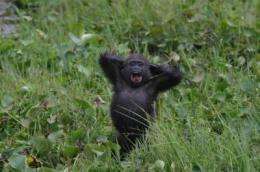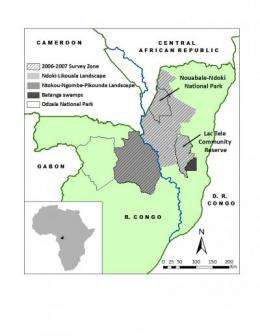A year after discovery, Congo's 'mother lode' of gorillas remains vulnerable

A new study by the Wildlife Conservation Society says that western lowland gorillas living in a large swamp in the Republic of Congo—part of the "mother lode" of more than 125,000 gorillas discovered last year—are becoming increasingly threatened by growing humans activity in the region.
The study recommends protection of the swamp forests adjacent to the southwest border of Lac Télé Community Reserve after recent surveys confirmed that high densities of the great apes still exist in the remote location.
The findings and recommendations appear in the November issue of the journal Oryx. The study's authors include: Hugo Rainey, Emma Stokes, Fiona Maisels, Samantha Strindberg, Fortuné Iyenguet, Guy-Aimé Malanda, and Bola Madzoké from the Wildlife Conservation Society: and Domingos Dos Santos from the Republic of Congo Minstčre de l'Economie Forestičre.
The swamp also supports large numbers of chimpanzees, red colobus monkeys, elephants, and other rain forest species. According to the study, imminent threats to the swamp include new logging operations, oil exploration, an influx of refugees from neighboring Democratic Republic of Congo, and, resulting from these developments, an increase in the human population, construction of roads and other infrastructure, and the escalation of the illegal bushmeat trade.
"We implore both the Government of the Republic of Congo and the international community to begin the groundwork for the creation of a new protected area to safeguard these gorillas and their unique environment for the benefit of future generations," said Dr. James Deutsch, WCS Director for Africa Programs. "Losing gorillas in this region after all the attention from their discovery would be a sad coda on an otherwise great story."

"The world was electrified at the discovery of more than 125,000 western lowland gorillas still in existence in the heart of Africa's rain forests, which include the recently surveyed gorillas just outside of Lac Télé," said WCS researcher Dr. Hugo Rainey, the paper's lead author. "Now that the thrill is gone, we can't forget about the most important part of wildlife surveys: protecting what we find."
Using methodologies based on counting the nests constructed by gorillas and the decay rates of these temporary structures, the researchers calculated that the study area (measuring 1,029 square kilometers, or 379 square miles, in size) contained an estimated population of 5,042 gorillas, more in fact than previous estimates for the site. The result is one of the highest density estimates ever calculated for gorillas—more than five gorillas per square kilometer (more than 13 gorillas per square mile).
The study site was the easternmost part of the gorilla census announced last year that produced a jaw-dropping estimate of more than 125,000 western lowland gorillas for the region.
Source: Wildlife Conservation Society (news : web)

















